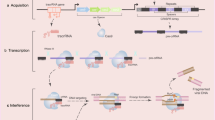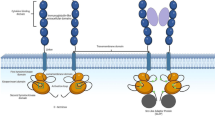Abstract
Recurrent reciprocal chromosomal translocations are frequently found in leukaemias and sarcomas as initiating events in these cancers. Mouse models of chromosomal translocations are not only important for the elucidation of the mechanism of these factors underlying the disease but are also important pre-clinical models for assessing new drug combinations, developing new rational therapeutic strategies based on new drugs and testing novel macromolecular drugs. We describe three technologies for creating chromosomal translocation mimics in mice, applied specifically to understand how the MLL-fusions contribute to leukaemia. An important finding of this work is that the lineage of the tumours can be controlled by the MLL-protein fusion. The translocation mimic methods can be applied to any human reciprocal chromosomal translocation.





Similar content being viewed by others
References
Rowley JD. Rearrangements involving chromosome 11Q23 in acute leukaemia. Semin Cancer Biol. 1993;4(6):377–85.
Ayton PM, Cleary ML. Molecular mechanisms of leukemogenesis mediated by MLL fusion proteins. Oncogene Rev. 2001;20:5695–707.
Look AT. Oncogenic transcription factors in the human acute leukemias. Science 1997;278:1059–65.
Pui C-H, Behm FG, Raimondi SC, Dodge RK, George SL, Rivera GK, Mirro J, Kalwinsky DK, Dahl GV, Murphy SB, Crist WM, Williams DL. Secondary acute myeloid leukemia in children treated for acute lymphoid leukemia. N Eng J Med. 1989;321:136–42.
Huret JL, Dessen P, Bernheim A. An atlas of chromosomes in hematological malignancies. Example: 11q23 and MLL. Leukaemia. 2001;15:987–99.
Zeleznik-Le NJ, Harden AM, Rowley JD. 11q23 translocations split the “AT-hook” cruciform DNA-binding region and the transcriptional repression domain from the activation domain of the mixed-lineage leukemia (MLL) gene. Proc Natl Acad Sci USA. 1994;91(22):10610–4.
Xia ZB, Anderson M, Diaz MO, Zeleznik-Le NJ. MLL repression domain interacts with histone deacetylases, the polycomb group proteins HPC2 and BMI-1, and the corepressor C-terminal-binding protein. Proc Natl Acad Sci USA. 2003;100(14):8342–7.
Slany RK, Lavau C, Cleary ML. The oncogenic capacity of HRX-ENL requires the transcriptional transactivation activity of ENL and the DNA binding motifs of HRX. Mol Cell Biol. 1998;18:122–9.
Milne TA, Briggs SD, Brock HW, Martin ME, Gibbs D, Allis CD, Hess JL. MLL targets SET domain methyltransferase activity to Hox gene promoters. Mol Cell. 2002;10(5):1107–17.
Nakamura T, Mori T, Tada S, Krajewski W, Rozovskaia T, Wassell R, Dubois G, Mazo A, Croce CM, Canaani E. ALL-1 is a histone methyltransferase that assembles a supercomplex of proteins involved in transcriptional regulation. Mol Cell. 2002;10(5):1119–28.
Gu Y, Cimino G, Alder H, Nakamura T, Prasad R, Canaani O, Moir DT, Jones C, Nowell PC, Croce CM, et al. The (4;11)(q21;q23) chromosome translocations in acute leukemias involve the VDJ recombinase. Proc Natl Acad Sci USA. 1992;89(21):10464–8.
Lobato MN, Metzler M, Drynan LF, Forster A, Pannell R, Rabbitts TH. Modeling chromosomal translocations using conditional alleles to recapitulate initiating events in human leukemias. J Natl Canc Inst. 2007, in press.
Corral J, Lavenir I, Impey H, Warren AJ, Forster A, Larson TA, Bell S, McKenzie ANJ, King G, Rabbitts TH. An Mll-Af9 fusion gene made by homologous recombination causes acute leukemia in chimeric mice: a method to create fusion oncogenes. Cell. 1996;85:853–61.
Dobson CL, Warren AJ, Pannell R, Forster A, Lavenir I, Corral J, Smith AJH, Rabbitts TH. The Mll-AF9 gene fusion in mice controls myeloproliferation and specifies acute myeloid leukaemogenesis. EMBO J. 1999;18:3564–74.
Collins EC, Pannell R, Simpson EM, Forster A, Rabbitts TH. Inter-chromosomal recombination of Mll and Af9 genes mediated by cre-loxP in mouse development. EMBO Rep. 2000;1:127–32.
Forster A, Pannell R, Drynan LF, McCormack M, Collins EC, Daser A, Rabbitts TH. Engineering de novo reciprocal chromosomal translocations associated with Mll to replicate primary events of human cancer. Cancer Cell. 2003;3:449–58.
Cano F, Drynan LF, Pannell R, Rabbitts TH. Leukaemia lineage specification caused by cell-specific Mll-Enl translocations. 2007, in press.
Higuchi M, O’Brien D, Kumaravelu P, Lenny N, Yeoh EJ, Downing JR. Expression of a conditional AML1-ETO oncogene bypasses embryonic lethality and establishes a murine model of human t(8;21) acute myeloid leukemia. Cancer Cell. 2002;1:63–74.
Forster A, Pannell R, Drynan LF, Codrington R, Daser A, Metzler M, Lobato MN, Rabbitts TH. The invertor knock-in conditional chromosomal translocation mimic. Nat Methods. 2005;2:27–30.
Drynan LF, Pannell R, Forster A, Chan NMM, Cano F, Daser A, Rabbitts TH. Mll fusions generated by Cre-loxP-mediated de novo translocations can induce lineage reassignment in tumorigenesis. EMBO J. 2005;24:3136–46.
McCormack MP, Forster A, Drynan LF, Pannell R, Rabbitts TH. The LMO2 T-cell oncogene is activated via chromosomal translocations or retroviral insertion during gene therapy but has no mandatory role in normal T-cell development. Mol Cell Biol. 2003;23:9003–13.
Codrington R, Pannell R, Forster A, Drynan LF, Daser A, Lobato MN, Metzler M, Rabbitts TH. The Ews–ERG fusion protein can initiate neoplasia from lineage committed haematopoietic cells. Publ Lib Sci Biol. 2005;3:e242.
Metzler M, Forster A, Pannell R, Arends MJ, Daser A, Lobato MN, Rabbitts TH. A conditional model of MLL-AF4 B-cell tumourigenesis using invertor technology Oncogene. 2006;25:3093–103.
Author information
Authors and Affiliations
Corresponding author
About this article
Cite this article
Rodriguez-Perales, S., Cano, F., Lobato, M.N. et al. MLL gene fusions in human leukaemias: in vivo modelling to recapitulate these primary tumourigenic events. Int J Hematol 87, 3–9 (2008). https://doi.org/10.1007/s12185-007-0001-3
Received:
Accepted:
Published:
Issue Date:
DOI: https://doi.org/10.1007/s12185-007-0001-3




